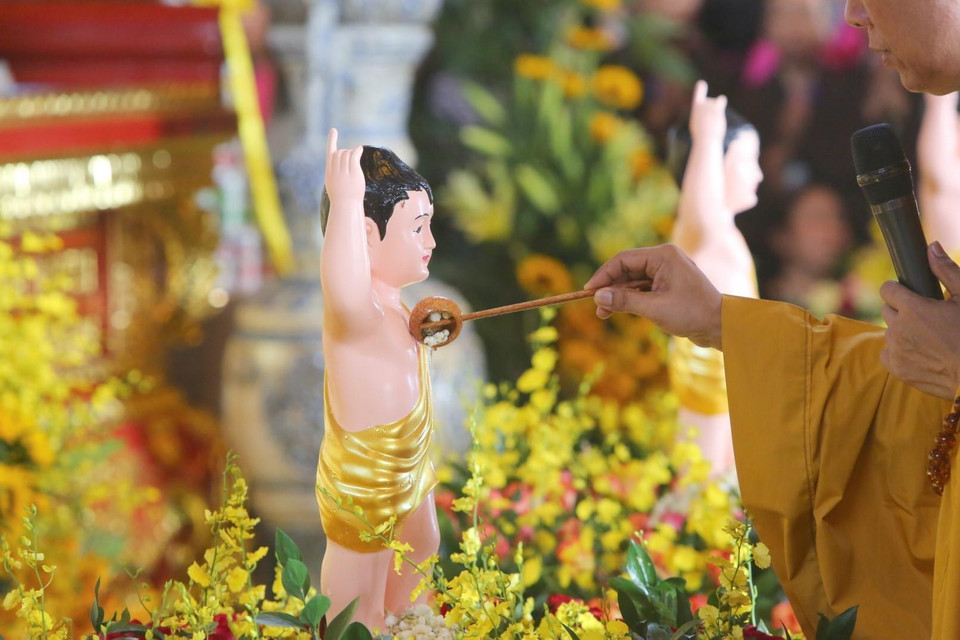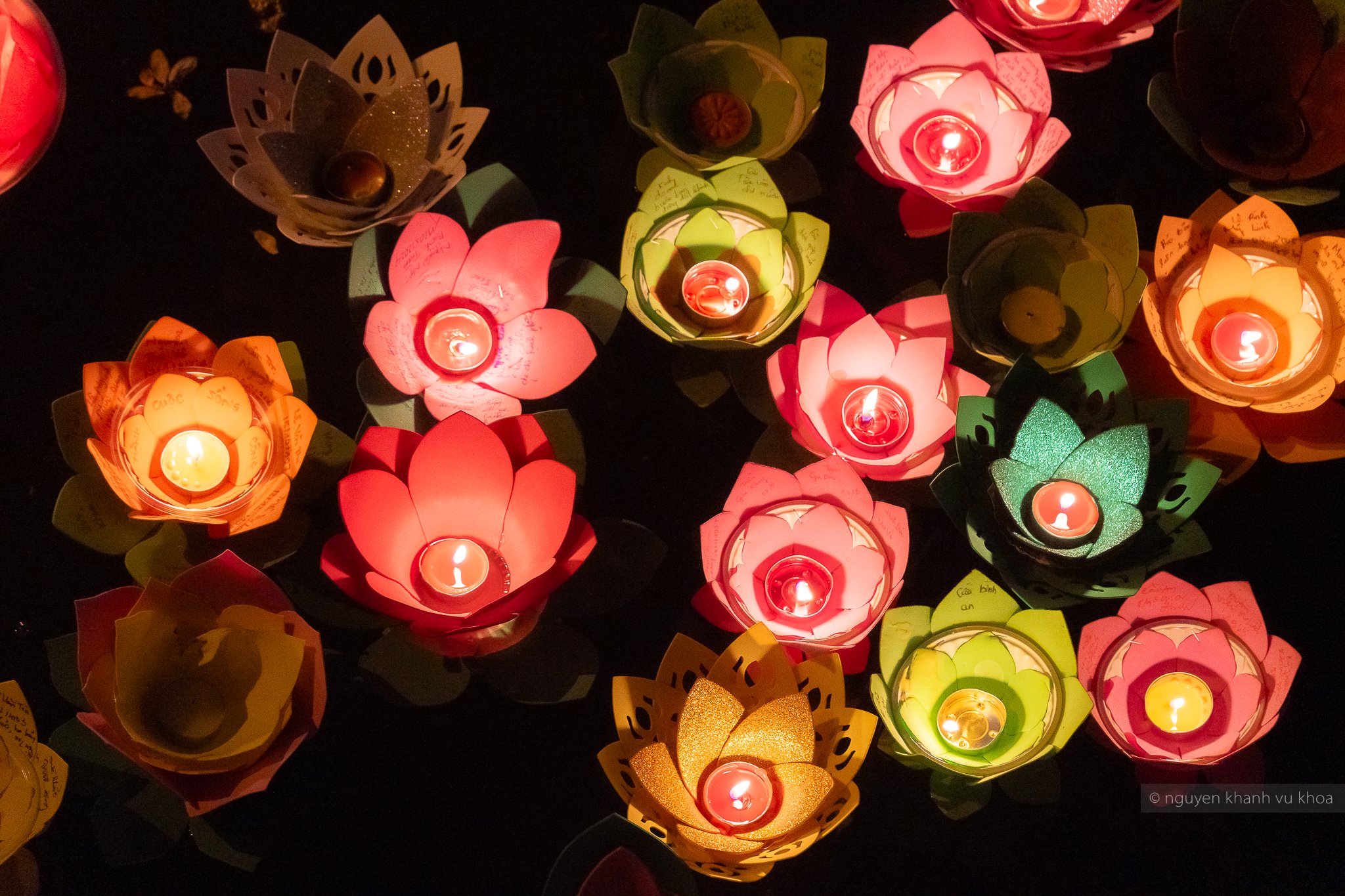- May 7, 2025
Vesak: The Global Celebration of Buddha’s Life and Its Profound Meaning in Vietnam and Beyond
Vesak, also known as the United Nations Day of Vesak, is one of the most sacred and significant holidays in Buddhism. Celebrated by millions of Buddhists across the globe, this event honors the birth, enlightenment, and passing of Gautama Buddha. In this article, we’ll explore the origins, spiritual significance, and global celebrations of Vesak—especially how it’s observed in Vietnam.

Each year, amidst the vibrant colors of flower lanterns and the smoke of incense, millions of Buddhists worldwide turn their hearts towards a significant spiritual event – the United Nations Day of Vesak. Photo: VnExpress.
1. What Is Vesak and Why Is It Important?
Vesak: Commemorating the Buddha’s Birth, Enlightenment, and Passing
The word Vesak is derived from the Pali term Vaisakha, the name of a month in the ancient Indian calendar. It marks three pivotal events in the life of the Buddha—his birth, his attainment of enlightenment, and his final passing into Nirvana. In Theravāda Buddhist traditions, these three sacred events are celebrated together on the full moon day of May, often referred to as the "Triple Blessed Day."

From a Local Tradition to a Global Event
After decades of advocacy, the United Nations officially recognized Vesak as an international religious and cultural holiday in 1999 through Resolution 54/115. Since then, it has been commemorated annually at the UN headquarters in New York and in member countries worldwide.
This recognition not only honors one of the world’s oldest religions but also acknowledges Buddhism's contributions to peace, compassion, and ethical living in a modern world.
A Universal Message of Peace and Compassion
Vesak transcends religious boundaries. It’s a moment for humanity to reflect on values like peace, mindfulness, respect for life, and ethical living—principles that resonate beyond Buddhism. In a time marked by global challenges such as conflict, inequality, and environmental degradation, the Buddha’s teachings on moderation, inner peace, and compassion serve as a guiding light for all.
2. How Is Vesak Celebrated Around the World?
A Multitude of Traditions and Expressions
Vesak is celebrated with vibrant festivals and spiritual rituals across Buddhist countries. One common tradition is the Bathing the Buddha ceremony, where devotees pour fragrant water over Buddha statues as a symbol of purification. Many communities also hold peace marches, offer alms, chant sutras, meditate, and engage in acts of charity and animal liberation.

Photo: Vietnam+
The Magical Glow of Lanterns
One of the most iconic and visually stunning traditions during Vesak is the lantern festival.
Thousands of glowing lotus-shaped lanterns are released into rivers or float into the night sky, symbolizing wisdom and enlightenment spreading across the world. International Buddhist conferences are also held, attracting scholars and practitioners to share insights and foster cross-cultural understanding.

During the Vesak celebration on the full moon of the fourth lunar month, the ritual of releasing flower lanterns carries the meaning of praying for peace for all and national well-being, reflecting the Buddhist principle of compassion. Photo: Nguyễn Khánh Vũ Khoa.
Cultural Diversity, Spiritual Unity
Each country adds its unique cultural flavor to Vesak:
-
Thailand: Celebrations are held in grand temples with ceremonial bathing of Buddha statues and candle-lit processions.
-
Sri Lanka: Streets are adorned with colorful lanterns, and Buddhist families offer free tea and snacks to guests as an act of generosity.
-
South Korea: The Yeon Deung Hoe Lantern Festival features thousands of intricate paper lanterns.
-
Myanmar: Devotees pour water on Bodhi trees and engage in large-scale charitable acts.
-
Japan: Known as Hanamatsuri (Flower Festival), Vesak includes bathing a baby Buddha statue with sweet tea.

Despite regional differences, the essence remains unchanged: honoring the Buddha’s life and spreading messages of compassion, wisdom, and peace.
3. Vesak in Vietnam: A Proud Host of Global Celebrations
Vietnam’s Role on the Global Buddhist Map
Vietnam has emerged as a key player in the global Buddhist community, having hosted the United Nations Day of Vesak four times. These milestones reflect not only the vibrancy of Vietnamese Buddhism but also the country’s growing spiritual and cultural influence.
-
2008 – Hanoi: The first international Vesak in Vietnam welcomed nearly 2,000 delegates from over 60 countries.
-
2014 – Bai Dinh Pagoda, Ninh Binh: A grander celebration with around 10,000 attendees.
-
2019 – Tam Chuc Pagoda, Ha Nam: Recognized by the World Records Union as the largest Vesak celebration, drawing 1,650 international and 20,000 domestic participants.
-
2025 – Ho Chi Minh City: Scheduled for May 6–8, 2025, under the theme “Harmony and Inclusiveness for Human Dignity: Buddhist Wisdom for World Peace and Sustainable Development.” This year’s Vesak also coincides with the 50th anniversary of Vietnam’s reunification.

Photo: TTXVN
Vietnam Buddhist Sangha: Bridging Global and Local Traditions
As the primary organizer, the Vietnam Buddhist Sangha has collaborated closely with the International Council for the Day of Vesak (ICDV) and received strong support from the Vietnamese government. These efforts have positioned Vietnam as a spiritual and cultural bridge between Buddhist traditions worldwide.
The themes of past Vesak celebrations in Vietnam reflect a commitment to social responsibility—ranging from sustainable development to global leadership and peace-building. This alignment of Buddhist philosophy with modern challenges showcases the evolution of Vietnamese Buddhism in a globalized world.

President Lương Cường is scheduled to attend the opening ceremony of Vesak 2025. Photo: CAND
Blending Tradition with Modernity
Vietnam’s Vesak celebrations strike a balance between global integration and cultural preservation. Pagodas such as Bai Dinh, Tam Chuc, and the Vietnam Buddhist Academy in Ho Chi Minh City are stunning examples of modern Buddhist architecture that retain traditional aesthetics—graceful curved roofs, intricate carvings, and culturally rich art forms.
This harmonious blend reflects a key strength of Vietnamese Buddhism: openness to dialogue and international cooperation, while preserving its distinct identity.
4. Meaningful Ways to Celebrate Vesak for a Mindful Life
Join Vesak Celebrations with a Heart of Reverence
Vesak is not only a sacred time for honoring the Buddha’s birth, enlightenment, and passing, but also a powerful opportunity to reconnect with peace, clarity, and compassion.
Participating in ceremonies at local temples—such as the Buddha bathing ritual, lantern lighting, chanting, and offering fruits or flowers—helps cultivate mindfulness and inner peace while expressing gratitude for the Buddha’s teachings.
For those seeking a deeper connection, acts like animal release (a symbol of compassion), charitable giving, or attending short meditation retreats offer space to reflect, reset, and realign with spiritual values. Practicing the Five Precepts—non-violence, honesty, ethical conduct, mindfulness, and sobriety—is a timeless way to bring the Dharma into everyday life.
Live and Share the Spirit of Peace
The spirit of Vesak extends beyond the temple—it lives in our daily actions. A kind word instead of a complaint, an act of generosity, or simply listening with presence can become spiritual practices. Mindful living—through conscious eating, walking, speaking, and working—invites us to live with presence and ease, reducing stress in a fast-paced world.
In an age of consumption and distraction, the Buddha’s guidance on simplicity and moderation is more relevant than ever. Embracing mindful consumption—buying less, reusing more, and being grateful for what we already have—is both an ecological and spiritual act that aligns with non-attachment and compassion.
Spiritual Gifts That Nourish the Soul
Giving during Vesak can also become an act of mindfulness. Thoughtful gifts—such as lotus-shaped lanterns (symbols of wisdom and awakening), meaningful calligraphy, statues of the Buddha, or books on Buddhist teachings—can inspire reflection and support others on their path.
Even simple, handcrafted items made from sustainable or recycled materials—like fabric totes, lanterns, or bracelets made by local artisans—carry deep meaning. They not only honor the earth and support traditional crafts, but also embody the Buddhist spirit of interbeing, where every gift becomes a gesture of love and connection.
Conclusion: Vesak as a Beacon for Humanity
The United Nations Day of Vesak is more than a religious observance—it’s a global celebration of peace, human dignity, and ethical living. Whether you're a practicing Buddhist or simply someone seeking meaning in today’s complex world, Vesak offers a moment to reconnect with values that transcend culture and belief.
As Vietnam continues to play a vital role in hosting and shaping this international event, its message of compassion, harmony, and wisdom shines brightly—reminding us that enlightenment is not just a path for the individual, but a light for the whole world.
















